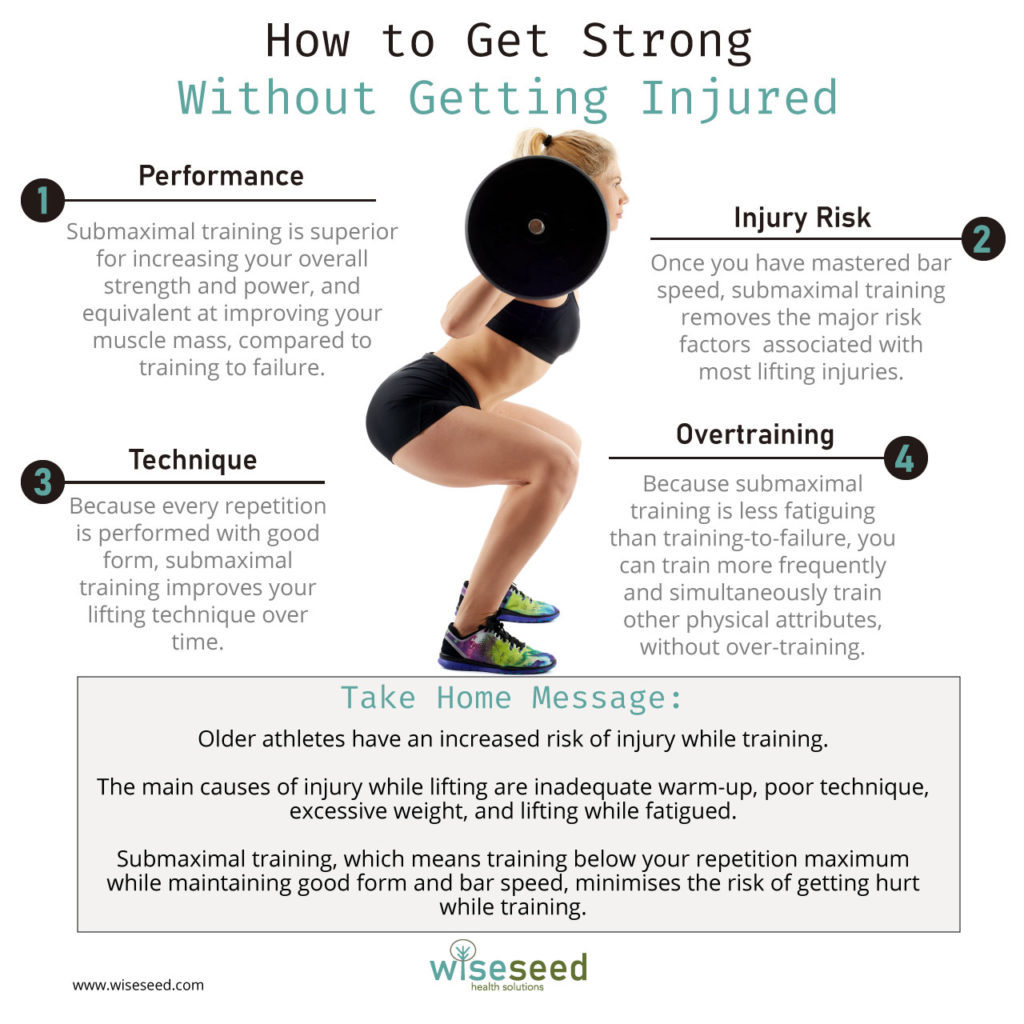How to Get Strong Without Getting Injured

“An ounce of prevention is worth a pound of cure.”
Benjamin Franklin
As a result of experiencing several avoidable injuries, I’ve gained a deeper appreciation of how getting older increases your risk of being injured while training. This has motivated me to research training approaches that maximize the benefits of exercise, while minimizing the risk of injury.
The focus of this article is to help you reap the rewards of strength training without getting hurt.
Older adults can still train hard, but they must also train smart.
Make no mistake, maintaining your physical fitness is essential for you to avoid age-related frailty. And as I’ve discussed, there is simply no substitute for resistance training for building and maintaining your strength, power, and muscle mass into old age.
However, any form of training becomes increasingly risky as you get older. For example, Masters runners at an international competition reported an injury rate of a whopping 49% during their previous 12 months of training (1)! Consistent with this observation, older athletes who engage in resistance training also experience a higher rate of injury compared to younger lifters (2-4). The most common sites of injury for older lifters are the shoulder, lower back, and knees (2-4).
This means that training programs for older adults must be carefully designed to minimize the risk of injury.
Why do strength athletes get injured?
Researchers asked strength athletes which factors contributed most to their sport-related injuries.
Weightlifters reported that 60 % of their injuries were associated with fatigue, 31 % were associated with poor technique, and 21 % with using excessive weight (2). Bodybuilders reported that 21 % of their injuries were caused by fatigue, 18 % by training with an overly heavy weight, and 14 % by insufficient warm-up (2). Athletes participating in Strongman reported that poor technique was the primary cause of their injury (2).
From this, we can infer four important principles that should inform any strength training program. These are:
- Adequate Warm-up
- Appropriate load (weight)
- Optimal lifting technique
- Not lifting while fatigued
Training to Failure
A widely used approach to strength training and bodybuilding is training to failure (5, 6). Muscular failure occurs during a resistance exercise set when the muscles can no longer produce sufficient force to control a given weight (5). For example, if you perform a set of 10 repetitions of bench press, and the final tenth repetition is the absolute last repetition that you can physically perform, you have trained to failure. This weight is your 10-rep maximum (10RM) for the bench press. Common repetition maximums used in programming are the 10RM, the 5RM, the 3RM and (you guessed it) the 1RM.
There are several reasons why athletes train to failure. First, because training to failure activates all your muscle fibers, it (in theory) provides the largest possible training stimulus to drive muscle growth and neuro-muscular adaptation (5, 6). Second, training to failure increases the secretion of growth hormones, which may further increase muscle growth (5, 6). Finally, because going to failure is the most accurate way to determine your maximal strength, it’s the most reliable method for measuring progress.
It’s important to know that the authors cited above take great pains to highlight that training to failure entails risk, and therefore must be carefully programmed (5, 6). In fact, their recommendation is that training to failure is best used by advanced lifters seeking to overcome training plateaus or to maximize muscle growth (5, 6). Further, they state that ‘For older adults and individuals who lift recreationally for the purpose of improving physical function, there is no reason to train to failure’ (5).
Thus, although training to failure certainly has merit for highly trained athletes, the experts believe that it is not appropriate for most recreational lifters. Note that this is especially true for older adults.
The Benefits of Submaximal Training
Submaximal training simply means that you train below your repetition maximum. In other words, you always end each of your sets at 1-3 reps shy of failure.
Over the age of 50, you rapidly lose your strength, power, and muscle mass. Because training to failure can improve all of these qualities (6), it remains an important question as to whether you really should avoid training to failure. After all, shouldn’t you use every tool available to preserve muscle function into old age?
Fortunately, two recently published meta-analyses have addressed this question (7, 8). Dr Jozo Grgic and Colleagues analyzed 15 clinical trials (7), and Dr Alexandra Vieira and Colleagues analyzed 13 clinical trials (8) that directly compared the effectiveness of training-to-failure to submaximal training.
Strength
When training volume is identical, there is no difference in strength gains when training-to-failure compared to submaximal training (7, 8). Thus, submaximal training provides the same strength gains as training-to-failure. However, Viera and Colleagues found that submaximal training is superior to training-to-failure for strengthening the lower body (8).
Conclusion: For your upper body, submaximal training is as effective at improving strength as training to failure. Importantly, submaximal training is superior to training-to-failure for increasing the strength of your lower body.
Muscle Growth (Hypertrophy)
When training volume is identical, there is no difference between submaximal training and training-to-failure with respect to muscle growth (7, 8). However, there is one caveat to this statement. In highly trained athletes, training-to-failure provides greater muscle growth in the muscles of the upper body compared to submaximal training (8).
Conclusion: For recreational lifters, submaximal training is as effective as training-to-failure for increasing muscle mass. However, for highly trained athletes, training to failure is more effective for increasing the muscle mass of their upper body.
Power
Muscle power is an essential characteristic for athletic performance and for daily functioning into old age (8). When comparing identical training volumes, submaximal training was as effective as training-to-failure for increasing muscle power (8). Despite this result, submaximal training is likely to be more effective than training-to-failure for increasing power. This is because using shorter sets while moving at high speed with less fatigue is known to induce the greatest improvements in muscle power output (9).
Unfortunately, few clinical trials comparing training-to-failure to submaximal training used maximal velocity in their training. This explains why submaximal training didn’t outperform training-to-failure in improving power in the meta-analysis (8). However, those trials that used maximal velocity (for example (10)) did show that submaximal training is superior for developing power.
Conclusion: Submaximal training is superior to training-to-failure for developing muscle power, provided you use short sets (i.e. 3-4 reps), execute lifts at a high speed, and don’t train while fatigued.
The Importance of Bar Speed
While many people obsess about the amount of weight on the bar, few people consider bar speed. This is a mistake.
To get the most out of submaximal training, you need to move the weight ‘fast’ while maintaining perfect technique. Keep in mind that bar speed is a relative concept. It’s different for everyone, and it varies for different exercises and different rep ranges. For example, your dumbbell bench speed is likely slower than your barbell bench speed because dumbbells require more control than barbells. Thus, you will have an optimal bar speed for each exercise and rep range that you perform.
For each repetition, your bar speed should be maintained at the optimal speed. If the bar start slowing down, stop the set. Either you are lifting in a fatigued state, or the weight is too heavy for that exercise and rep range.
When you get it right, appropriate bar speed means that you always lift with good technique, you don’t lift in a fatigued state, and the weight selected is appropriate for the exercise and rep range you are doing. This eliminates three of the primary causes of lifting injury (i.e. lifting in a fatigued state, technique breakdown, and using too heavy a load). An added bonus is that because you always lift with good form, your technique improves over time.
An important benefit to submaximal training with optimal bar speed, is that the workouts are far less fatiguing that training to failure (8). Because of this, you recover more quickly (8). This means that you can (i) train more frequently; and (ii) train other physical attributes, such as endurance and skill.
Take Home Message
- Submaximal training is superior for increasing your overall strength and power, and equivalent at improving your muscle mass, compared to training to failure.
- Once you have mastered bar speed, submaximal training removes the major risk factors associated with most lifting injuries.
- Because every repetition is performed with good technique, submaximal training improves your lifting technique over time.
- Because submaximal training is less fatiguing than training-to-failure, you can train more frequently and simultaneously train other physical attributes, without over-training.
Please click on the link below for your free PDF.

References and Further Reading
1. K. A. McKean, N. A. Manson, W. D. Stanish, Musculoskeletal injury in the masters runners. Clin J Sport Med 16, 149-154 (2006).
2. J. W. Keogh, P. W. Winwood, The Epidemiology of Injuries Across the Weight-Training Sports. Sports Med 47, 479-501 (2017).
3. M. Huebner, D. Meltzer, W. Ma, H. Arrow, The Masters athlete in Olympic weightlifting: Training, lifestyle, health challenges, and gender differences. PLoS One 15, e0243652 (2020).
4. M. Rodríguez et al., Injury in CrossFit®: A Systematic Review of Epidemiology and Risk Factors. Phys Sportsmed, 1-8 (2021).
5. J. M. Willardson, The application of training to failure in periodized multiple-set resistance exercise programs. J Strength Cond Res 21, 628-631 (2007).
6. J. M. Willardson, L. Norton, G. Wilson, Training to failure and beyond in mainstream resistance exercise programs. Strength & Conditioning Journal 32, 21-29 (2010).
7. J. Grgic, B. J. Schoenfeld, J. Orazem, F. Sabol, Effects of resistance training performed to repetition failure or non-failure on muscular strength and hypertrophy: A systematic review and meta-analysis. J Sport Health Sci, (2021).
8. A. F. Vieira et al., Effects of Resistance Training Performed to Failure or Not to Failure on Muscle Strength, Hypertrophy, and Power Output: A Systematic Review With Meta-Analysis. J Strength Cond Res 35, 1165-1175 (2021).
9. F. Pareja‐Blanco et al., Effects of velocity loss during resistance training on athletic performance, strength gains and muscle adaptations. Scandinavian Journal of Medicine & Science in Sports 27, 724-735 (2017).
10. M. Izquierdo, R. Exposito, J. Garcia-Pallare, L. Medina, E. Villareal, Concurrent endurance and strength training not to failure optimizes performance gains. Sci Sports Exerc 42, 1191-1199 (2010).
Acknowledgements
Images provided by xalanx and BartekSzewczyk
Disclaimer
The material displayed on this website is provided without any guarantees, conditions or warranties as to its accuracy.
Information written and expressed on this website is for education purposes and interest only. It is not intended to replace advice from your medical or healthcare professional.
You are encouraged to make your own health care choices based on your own research and in conjunction with your qualified practitioner.
The information provided on this website is not intended to provide a diagnosis, treatment or cure for any diseases. You should seek medical attention before undertaking any diet, exercise, other health program or other procedure described on this website.
To the fullest extent permitted by law we hereby expressly exclude all warranties and other terms which might otherwise be implied by statute, common law or the law of equity and must not be liable for any damages whatsoever, including but without limitation to any direct, indirect, special, consequential, punitive or incidental damages, or damages for loss of use, profits, data or other intangibles, damage to goodwill or reputation, injury or death, or the cost of procurement of substitute goods and services, arising out of or related to the use, inability to use, performance or failures of this website or any linked sites and any materials or information posted on those sites, irrespective of whether such damages were foreseeable or arise in contract, tort, equity, restitution, by statute, at common law or otherwise.

Ten Minutes is All You Need
Research has shown that ten minutes of moderate-to-vigorous exercise performed each day is enough to significantly reduce your risk of early death.

Strong Bones, Strong Mind
Regular exercise releases osteocalcin from your bones. Once in circulation, osteocalcin enters your brain to support learning and memory.




